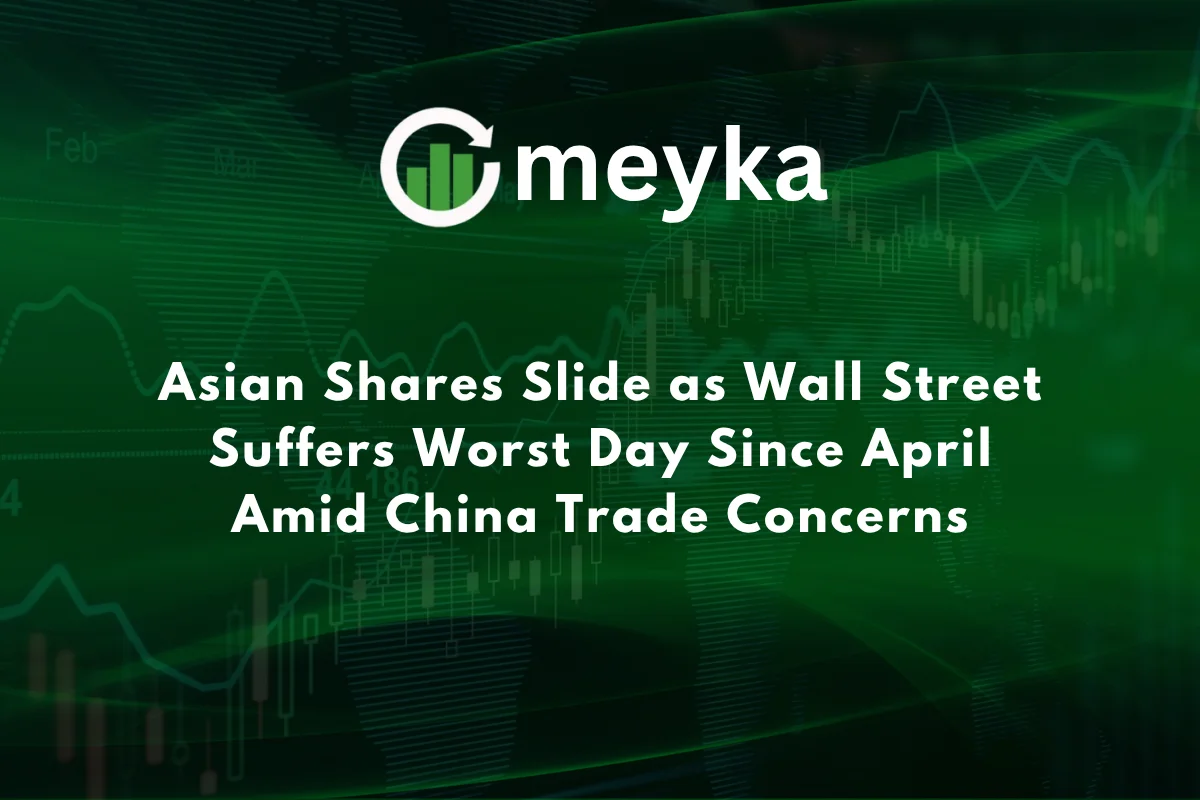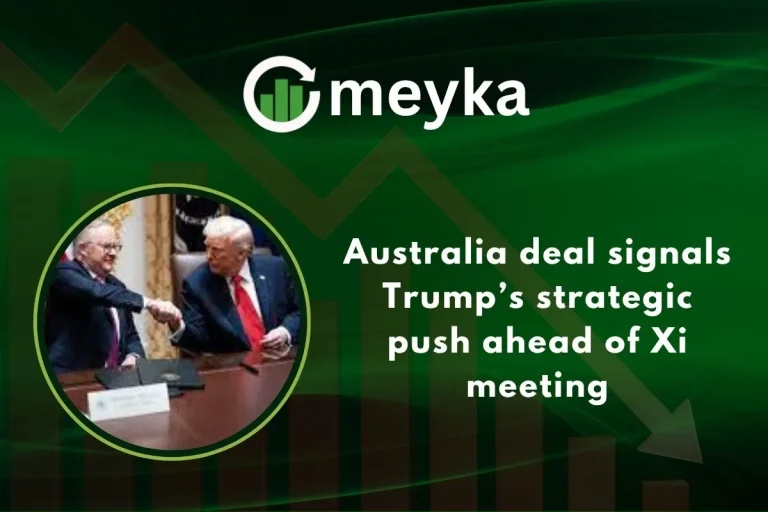Asian Shares Slide as Wall Street Suffers Worst Day Since April Amid China Trade Concerns
Global markets jolted this week, and Asian shares have not been spared. A sweeping liquidation across benchmark indexes followed Wall Street’s steepest single-day fall since April. Investors are now grappling with revived China trade concerns, renewed tariff threats, and uncertainty over how the tensions will ripple through AI stocks, industrial exports, and global supply chains.
Wall Street’s Collapse Sends Shockwaves Overseas
On Friday, the U.S. stock market plunged. The S&P 500 shed about 2.7%, the Dow Jones fell 1.9% (losing nearly 878 points), and the Nasdaq dropped roughly 3.6%.
This rout was triggered by a fresh escalation in the U.S.-China trade tensions. President Trump announced plans to impose 100% tariffs on Chinese goods and threatened additional export controls. Those moves reignited fears that the fragile calm in global financial markets was about to vanish entirely.
Traders are increasingly worried that global supply chains, especially in tech and semiconductor sectors, will be disrupted again or perhaps permanently restructured. In this environment, stock research is turning back to fundamentals, yield curves, and geopolitical risks.
Asian Markets Falter Under Global Pressure
As Wall Street collapsed, major Asian markets followed. The selloff was broad and deep:
- Hong Kong’s Hang Seng index fell around 2.2–3.5% depending on the session.
- Shanghai Composite declined about 1.3%, while the CSI 300 dropped nearly 1.8%.
- In South Korea, the Kospi shed 0.7-1.7%.
- Australian equities, measured by the ASX 200, fell 0.8–0.9%.
Markets in Tokyo were closed for a holiday, muting some of the regional impact. The declines reflect mounting investor anxiety over trade policies, global demand, and profit pressures, especially in technology and industrial sectors.
China Trade Risks: What’s Fueling the Fear
Tariff Shock & Policy Retaliation
The core of the panic lies in renewed expectations for tariff escalation. Trump’s threat of 100% tariffs on Chinese goods was a blunt move after months of relative calm. Beijing had already restricted exports of rare-earth materials, which are critical for manufacturing electronics, defense systems, and AI components.
While China has not immediately retaliated with sweeping tariffs, markets fear that additional actions, or hasty countermeasures, could be just around the corner.
Weak U.S. Demand & Export Shift
Latest data show China’s exports to the U.S. plunged nearly 27% year over year, even as overall exports rose. This suggests Chinese manufacturers are diversifying their customer base away from U.S. markets. Still, weakening American demand in an environment of higher tariffs compounds the uncertainty.
Technology & AI Exposure
One of the most vulnerable sectors is AI stocks and high-tech firms that rely on cross-border supply chains. Export controls on semiconductors and rare earths could choke access to key components. Some firms, especially specialized chipmakers, already see sharp valuation pressures as a result.
Market watchers warn that if trade tensions drag on, the valuation multiple enjoyed by many AI-related names may come under harsh scrutiny. Some fear a replay of dot-com excesses, as lofty expectations meet geopolitical and logistics headwinds.
Investor Sentiment & Yield Pressures
With global equities reeling, bond markets are reacting in tandem. Yields on U.S. Treasuries fell as investors sought safe havens, pressuring yields across Asia. The yield curve is being watched closely for signs of inversion, a classic recession signal.
In forex markets, the U.S. dollar gained strength against many Asian currencies, complicating borrowing costs and import dynamics for regional companies. Meanwhile, oil and commodities saw muted declines as demand projections softened.
Policy Response & Market Outlook
Central Banks Under Pressure
Many central banks in Asia are now walking a tightrope. On one hand, weak equity markets and export headwinds argue for stimulus or rate cuts. On the other hand, domestic inflation and currency stability remain concerns.
In China, stimulus tools, including fiscal support and credit easing, are expected to be deployed selectively. But intervention is tricky amid external pressures, capital outflows, and geopolitical exposure.
Trade Negotiations & Diplomatic Signals
Markets are holding out hope that negotiations will resume. Signs of diplomacy, or even small concessions, could help stabilize sentiment. That said, both sides are likely to use tariffs as negotiation leverage, meaning volatility may persist.
Sector Rotation & Defensive Moves
In the near term, we expect defensive stocks (utilities, consumer staples) and safe-haven themes (gold, quality bonds) to outperform. Some AI stocks with robust balance sheets may weather the storm, but high-loss speculative plays are at greatest risk.
Investors should monitor earnings reports, updates on trade talks, and central bank commentary. Maintaining a diversified strategy with hedges may prove to be critical.
How Asian Investors Should Adjust
- Reassess exposure to export-driven sectors. Manufacturers heavily dependent on U.S. demand or supply chains from the U.S. and China are under the greatest risk.
- Favor quality, cash-rich businesses. Companies with solid balance sheets and less reliance on external financing will better absorb shocks.
- Monitor AI stock valuations closely. The premium multiple on many AI and semiconductor names may retreat sharply.
- Hedge currency and yield risk. Use options or bond hedges where possible to buffer against downward pressure.
- Stay alert to policy shifts. Any change in trade or diplomatic tone can trigger abrupt market reversals.
Conclusion
The sharp drop in Asian shares reflects more than just contagion from Wall Street—it underscores deep-seated worries about a renewed U.S.-China trade war at a time when global growth is already fragile. With volatility likely to remain elevated, investors should lean into disciplined stock research, focus on cash flow and business fundamentals, and avoid speculative overreach in high-risk areas like AI.
FAQs
Because global equity markets are interconnected. The collapse in U.S. indexes sparked a wave of risk aversion. Coupled with renewed trade fears, investors in Asia sold shares preemptively to reduce exposure.
AI and tech stocks are especially vulnerable. Export controls and disrupted supply chains can erode margins and growth assumptions. Companies with diversified sourcing or strong local infrastructure will fare better.
Focus on companies with strong fundamentals, hold cash reserves, diversify across sectors, and consider hedging currency risk. Avoid over-leveraged or speculative positions until clarity returns.
Disclaimer:
This content is made for learning only. It is not meant to give financial advice. Always check the facts yourself. Financial decisions need detailed research.






